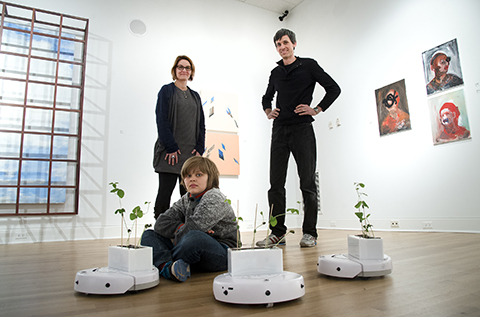Did You Know?: Electronic and Time-Based Art Program
December 11, 2014
 |
|
Shannon McMullen and Fabian Winkler with their son, Quinn McMullen Winkler, at the closing reception for the recent Art and Design Faculty Show at Patti and Rusty Rueff Galleries. Winkler and McMullen's "Soybots: Mobile Micro-Gardens" is their most recently completed Electronic and Time-Based Art project. (Purdue University photo/Mark Simons) |
Many academic departments at Purdue are equipped to analyze the intersection of technology and social issues, yet few can create the experiential, interactive displays that explain this intersection like the Electronic and Time-Based Art program.
ETB uses new media technologies, such as computers and cameras, to create artifacts with a cultural impact and a critical, explorative component, all with the goal of getting people to think and ask questions about contemporary culture. The time-based component is also crucial, as the art changes over time through some type of interaction, either in response to people or naturally over a set time period.
One of Fabian Winkler and Shannon McMullen's most recent ETB projects explores the interactions between nature, art and technology. In their "Soybots: Mobile Micro-Gardens" , the Soybots move around the space they occupy by searching for sources of light for the soybean plants. This interactive artwork is influenced by light and changes over time, a quintessential feature of ETB. In addition, the Soybots raise questions about the future of robotics in agriculture and how humans exist in this relationship.
Housed in the Patti and Rusty Rueff School of Visual and Performing Arts, ETB has been championing an interdisciplinary approach to asking questions about social issues since its inception in 2006. Although Winkler and McMullen are the sole ETB faculty members, they've been able to evolve the program through collaborations with faculty from different departments and colleges and by attracting undergraduates from myriad different majors to the program. The integration with other departments and Purdue as a whole has been instrumental in growing ETB.
"Interdisciplinary collaboration is a way to challenge your own perspective constantly," McMullen says. "If you are talking to somebody else who may be looking at the same technology but they understand it from a completely different perspective, it pushes you to think about your own assumptions. In pushing to think about your own assumptions, it's a place for a creative spark to happen."
Though Winkler and McMullen say that ETB evolves as their interests evolve, the duo also looks to ETB's students for new directions to take the program. Approximately 20 students from varying academic backgrounds are pursuing the five-course ETB minor. Three students are currently enrolled in the Master of Fine Arts program.
"It's a great place for asking critical questions for critical thinking," McMullen says. "It's a place you can think materially and see technology not just from the point of consumption, but from the point of production. I think there's something very useful about that."
Two graduate students will be participating in the spring MFA exhibitions. Alejandra Carillo-Munoz's exhibition will take place March 23-27. Oren Darling's exhibition will be April 13-17. Both exhibitions will be held in the Rueff Galleries in Pao Hall. The events are free and open to the public.
Writer: Kourtney Freiburger, 49-62993, kfreibu@purdue.edu

